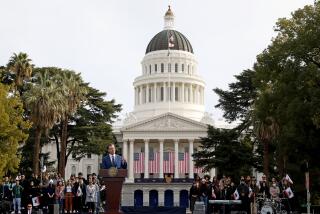Wilson’s Senate Replacement Is Likely to Be a Short-Timer : Politics: Voters have not favored appointed candidates. Whoever gets the job faces constant campaigning in order to win a full six-year term.
- Share via
Contrary to popular wisdom, Gov.-elect Pete Wilson won’t be doing any big favor for the person he appoints to take his seat in the U.S. Senate. The man or woman may get the short end of the stick, for the appointee stands only a 4 in 10 chance of winning election in his or her own right, the record shows.
According to the Senate Historical Office, 33 senators have been appointed nationwide since 1960. Seven served as caretakers, choosing not to run in the following election. Of the 26 who ran, only 11 won--a success rate of just above 40%.
The last Senate appointee from California was Pierre Salinger, now chief foreign correspondent for ABC in Europe. Salinger beat Alan Cranston in the June, 1964, Democratic primary, but then before the general election he accepted an appointment by former Gov. Edmund G. (Pat) Brown to succeed Sen. Clair Engle, who died that summer. Salinger still lost the general election to Republican song-and-dance man George Murphy.
The person who succeeds Wilson must stand for office at the next general election--by state law designed to ensure that no Senate appointee serve too long without voter approval. That puts the next vote just around the corner, in 1992; Wilson’s term expires in 1994, when there would be an election for a full six-year term. So whoever takes the job now, and wanting to continue, faces a constant four-year campaign and the burden of raising as much as $40 million to win two Senate elections in four years. Imagine the plunge in popularity any politician would take after that.
So why are so many preening for Wilson’s approval? If they really wanted to serve in the Senate representing this relatively nonpartisan state, it would be more logical to seek the seat of retiring Democratic Sen. Alan Cranston in 1992. A much better deal: Raise a campaign war chest of $20 million and have six years of job security. The political and mental-health risks involved in accepting Wilson’s two-year seat, compared with running for Cranston’s six-year post, should cause concerns about the judgment of whoever says “yes” to the governor-elect.
After a Florida Thanksgiving and a few days in Washington to tie up loose ends in his Senate office, Wilson returned Tuesday to Sacramento with the Senate seat topping his agenda. He wants it decided by mid-December so he can get on with the real headache of managing the multibillion-dollar deficit left him by a fellow Republican, Gov. George Deukmejian.
And about that Deukmejian rumor: He will not be Wilson’s choice for the Senate. Deukmejian refused to seek a third term because, after 28 years in public office, he wanted to practice law and more comfortably support his wife, Gloria.
But a dozen or so Republicans are waiting for Wilson to pop the question. Women are high on the governor-elect’s list. It would be a first, a visionary gesture and a counter to Democrat Dianne Feinstein’s possible Senate candidacy.
There are no back-room king- or queen-making deals being cut, as was the case when Ronald Reagan’s “kitchen cabinet” took it upon itself to decide Republican nominees.
Only three people know who is really under consideration, as opposed to the fictitious “short list” floated to pay respect to party conservatives and loyalists. They are Wilson and his wife, Gayle, of course, along with Bob White, the man who has served as Wilson’s chief of staff, confidant and alter ego since his San Diego mayoral days.
Kenneth L. Khachigian, a strategist for every GOP President since Richard M. Nixon, and a Wilson transition-team member, said, “Those who don’t know aren’t talking, and those who do know aren’t.”
So far the smart money has been on Carla Hills, the U.S. Trade Ambassador and former head of the Department of Housing and Urban Development under President Gerald R. Ford. She’s a Republican moderate, currently immersed in the negotiations over the General Agreement on Tariffs and Trade in Brussels.
Hills is personally close to Wilson and politically in sync with him. That means, says a source close to Hills, that she is a fiscal conservative and a social moderate.
Fund-raising ability is major consideration, and Hills can boast a wide spectrum of prominent California friends, from industrialist David Packard to Democrat Tom Bradley, who once attempted to name her to the Los Angeles Police Commission. An interesting twist: Hills was a Feinstein classmate at Stanford. The down side is that she’s never been tested on the campaign trail.
One would obviously look to recent candidates to run for the GOP nomination for the Senate. The 1986 state nominee, Ed Zschau, has taken himself out. The runner-up, TV commentator Bruce Herschensohn, is a staunch conservative and abortion foe.
Then there’s the California congressional delegation. Rep. Bill Thomas of Bakersfield is a liberal, continually taunted by conservatives at state GOP conventions. Reps. David Dreier of La Verne and Jerry Lewis of Highland are highly regarded within the party. Dreier is a proven fund-raiser with $1.6 million in the bank; but Lewis is a close Wilson friend.
Hills and Lewis, in that order, rank highest among those familiar with Wilson’s thinking before he ordered a gag rule on the process. Lewis may have an advantage, in Wilson’s view, because he is already an elected official--and does have a highly recognizable name.
The most intriguing name to surface so far is that of Condoleezza Rice. The National Security Council’s director of Soviet affairs, she is the highest-ranking black woman in the Bush Administration. Rice, a tenured associate professor of political science at Stanford, was recommended to Wilson last Monday by State Sen. Becky Morgan (R-Los Altos Hills), as Morgan removed herself from the list of potential appointees.
Orange County Supervisor Gaddi Vasquez is another possible, since Wilson would like to name a minority. But Vasquez was given a platform at the 1988 Republican National Convention and backed away from running this year.
Looking back on his experience, Salinger, the last Senate appointee from California, said recently, “I should not have accepted.
“If I had at that time put out a statement that I very much appreciated what Gov. Brown had done--but it was not my decision, but the decision of the people of California to decide . . . I think I would have won the election,” he said in a KABC-TV interview from London.
Salinger warned Wilson: “Appoint somebody who would like to have an interim term as senator until 1992. If it’s somebody who wants to extend their senatorial career, history proves in the United States that the chances of that person being reelected are very, very difficult . . . people do not like the idea of voting for someone who’s been appointed.”
Republicans grouse that if Wilson did make an interim appointment, he would rob the GOP of an incumbent’s fund-raising advantage. The only prospective candidate amenable to such a short-term slot appears to be Herschensohn.
“That’s OK with me,” he said in a conversation with me. “Two years would be just fine and the idea of not campaigning would be a gift.”
Sometimes there is a strategic reason for interim appointment. The Kennedys used one to save John F. Kennedy’s Senate seat in 1960 for brother Edward, who, at age 28, was two years short of the legal age to run. Elected President, J.F.K. asked that former classmate Benjamin Smith be named to his seat. Edward M. Kennedy turned 30 in 1962, and Smith bowed out.
A short-termer would allow Wilson’s pick to be a full-time senator, while another Republican raised money to run for the full term. This idea doesn’t currently appeal to Wilson. So he is left with deciding who can jump through these unprecedented series of political hoops over the next four years. The current joke is that Wilson could make his choice based on “the red-eye survival test”--put those under serious consideration on continuous, nightlong transcontinental flights and see who survives.
More to Read
Get the L.A. Times Politics newsletter
Deeply reported insights into legislation, politics and policy from Sacramento, Washington and beyond. In your inbox twice per week.
You may occasionally receive promotional content from the Los Angeles Times.









